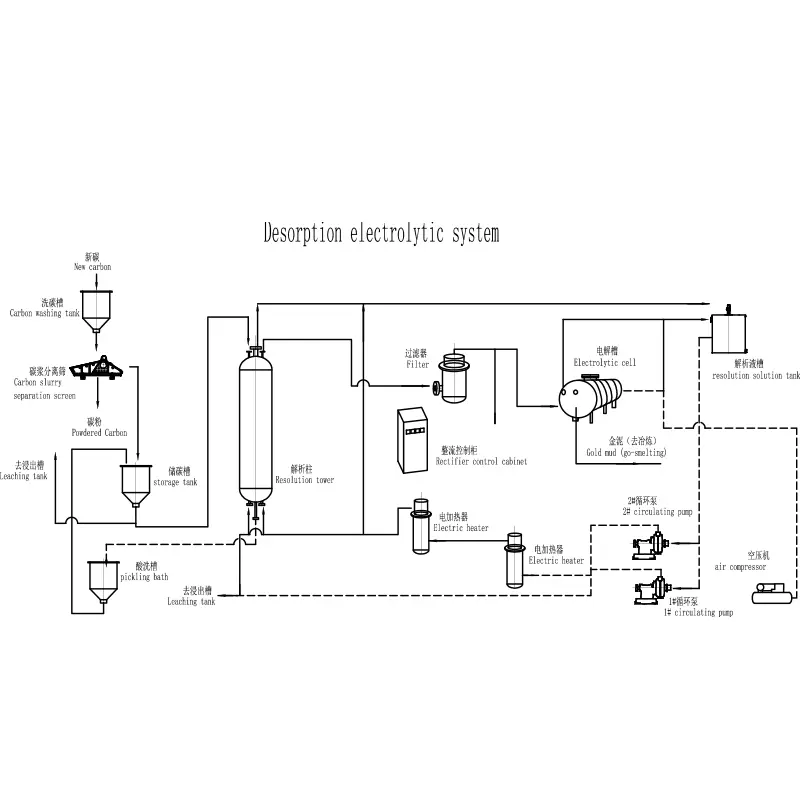 English
English Español
Español  Português
Português  русский
русский  Français
Français  日本語
日本語  Deutsch
Deutsch  tiếng Việt
tiếng Việt  Italiano
Italiano  Nederlands
Nederlands  ภาษาไทย
ภาษาไทย  Polski
Polski  한국어
한국어  Svenska
Svenska  magyar
magyar  Malay
Malay  বাংলা ভাষার
বাংলা ভাষার  Dansk
Dansk  Suomi
Suomi  हिन्दी
हिन्दी  Pilipino
Pilipino  Türkçe
Türkçe  Gaeilge
Gaeilge  العربية
العربية  Indonesia
Indonesia  Norsk
Norsk  تمل
تمل  český
český  ελληνικά
ελληνικά  український
український  Javanese
Javanese  فارسی
فارسی  தமிழ்
தமிழ்  తెలుగు
తెలుగు  नेपाली
नेपाली  Burmese
Burmese  български
български  ລາວ
ລາວ  Latine
Latine  Қазақша
Қазақша  Euskal
Euskal  Azərbaycan
Azərbaycan  Slovenský jazyk
Slovenský jazyk  Македонски
Македонски  Lietuvos
Lietuvos  Eesti Keel
Eesti Keel  Română
Română  Slovenski
Slovenski  मराठी
मराठी  Srpski језик
Srpski језик
Do You Know What Types Of Cyaniding Equipment There Are?
2025-04-03
Treatment of cyanide wastewater has always been a difficult problem in the chemical industry. So what are the main Cyaniding Equipment commonly used for cyanide wastewater treatment?

Sodium hypochlorite oxidation equipment: oxidize cyanide into non-toxic substances through the strong oxidizing property of sodium hypochlorite. Usually equipped with a sodium hypochlorite generator, sodium hypochlorite solution can be prepared on site. The device generally includes a chlorine generation unit, a dissolution unit and a metering unit. In the process of chlorine reacting with sodium hydroxide to generate sodium hypochlorite, the reaction conditions, such as chlorine flow rate, sodium hydroxide concentration, etc., need to be strictly controlled to ensure the quality of sodium hypochlorite and the accuracy of the dosage. This equipment is relatively simple to operate, but it requires high skills for the operator, and the reaction conditions need to be strictly controlled to avoid excessive or insufficient sodium hypochlorite, resulting in poor treatment effect of Cyaniding Equipment.
Chlorine dioxide oxidation equipment: Chlorine dioxide has stronger oxidizing properties and can oxidize cyanide more effectively. Its equipment includes a chlorine dioxide generator, and common ones are chemical generators and electrolytic generators. The chemical method generator generates chlorine dioxide by reacting hydrochloric acid with sodium chlorate or sodium chlorite, and needs to control the reaction material ratio and reaction temperature and other conditions; the electrolytic method generator uses electrolysis of salt solution to generate chlorine dioxide. The equipment structure is relatively complex and requires a stable power supply and electrolysis system. The chlorine dioxide oxidation method equipment has high treatment efficiency, but the cost and operation cost of cyaniding equipment are relatively high.
Alkaline copper chloride method equipment: copper chloride reacts with cyanide under alkaline conditions to convert cyanide into low-toxic or non-toxic substances. The equipment mainly includes a copper chloride solution preparation device and a reaction tank. The copper chloride solution needs to be prepared according to the cyanide concentration of the wastewater. In the reaction tank, the wastewater and the copper chloride solution are fully mixed and reacted by stirring. This method has a good treatment effect, but the copper sludge produced needs to be subsequently treated, otherwise it may cause secondary pollution.
Activated carbon adsorption method equipment: activated carbon has a huge specific surface area and rich pore structure, which can adsorb cyanide in wastewater. Commonly used equipment includes activated carbon adsorption towers. When wastewater passes through the activated carbon layer in the adsorption tower, cyanide is adsorbed on the surface of the activated carbon. The adsorption tower needs to be backwashed and regenerated regularly to restore the adsorption performance of the activated carbon. The activated carbon adsorption method has simple equipment and convenient operation, but the regeneration and replacement costs of activated carbon are high, and the adsorption capacity is limited, so the activated carbon needs to be replaced regularly.
Strong alkaline anion exchange resin equipment: Utilize the selective adsorption of cyanide by strong alkaline anion exchange resin to remove cyanide from wastewater. The equipment mainly includes ion exchange columns and regeneration devices. Strong alkaline anion exchange resin is filled in the ion exchange column. When the wastewater passes through the exchange column, cyanide is adsorbed by the resin, and the outflowing water meets the discharge standard. When the resin is saturated with adsorption, it needs to be regenerated with a regeneration agent to restore the adsorption capacity of the resin. The ion exchange method has good treatment effect and can remove cyanide, but the regeneration process of the resin is relatively complicated, requiring a large amount of regeneration agent, and the service life of the resin is limited, so it needs to be replaced regularly.
In addition, there are electrolysis treatment equipment. Different Cyaniding Equipment have their own advantages and disadvantages. In practical applications, it is necessary to comprehensively consider factors such as the nature of the wastewater, treatment requirements, and cost, and select appropriate treatment equipment or combine multiple equipment to achieve the best treatment effect.




